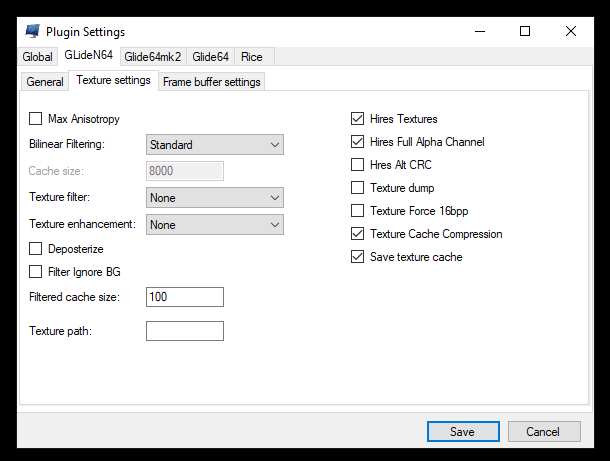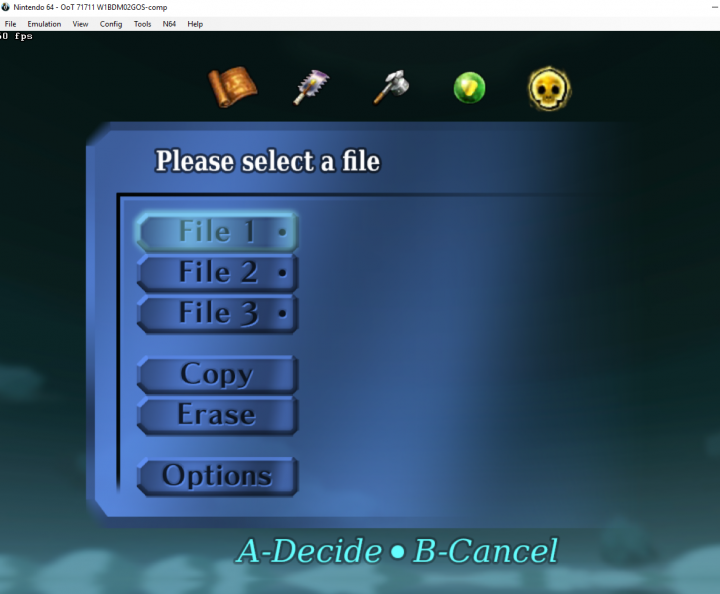How to use HiRes Texture packs
Bizhawk
To apply texture packs in Bizhawk you need to do the following steps:
1. Start Bizhawk and open the N64 Plugin Settings
2. Select GLideN64 and select the Texture settings tab
3.Enable the following options:
HiresTextures, Hires Full Alpha Channel, Texture Cache Compression and Save Texture Cache

4. Download your favourite texture pack for GLide64 in .htc format. (e.g. the completed packs on EmuTalk)
5. Make sure the filename of the downloaded pack is THE LEGEND OF ZELDA_HIRESTEXTURES.htc
6. Put the file in the following folder: %UserProfile%\AppData\Roaming\Mupen64Plus\cache
- If there is no cache folder, visit %UserProfile%\AppData\Roaming\Mupen64Plus\ and create one!

If done correctly you should immediately see the new textures:

Retroarch
For hi-res texture packs on Retroarch, you will need to be running the Mupen64Plus core; ParaLLEL does not support them.
- You will first need to obtain a compatible .HTC texture pack (e.g. from the completed projects section on emutalk).
- Navigate to your RetroArch installation folder (By default, this is
%AppData%\RetroArchon Windows) - Navigate to
.\system\Mupen64plus\cache - Place your texture packs within the
cachefolder - Load the ROM with the Mupen64Plus core selected
- Finally, enable the option
Quick Menu -> Options -> Use High-Res texturesandUse High-Res Full Alpha Channel - Reload the content
- You should now have your texture pack active.
Project64
There are two styles of texture packs you can use on Project64: Rice-format (a large collection of .PNG files) or precompiled .HTC packs.
For precompiled packs:
Extract the .HTC to \Project64\Textures\GLideN64\cache\
- If \GLideN64\cache\ doesn't exist, go to \Project64\Textures\ and create it!
Download the latest GLideN64 release from https://github.com/gonetz/GLideN64/releases
- In the downloaded \GLideN64_Public_Release_3.0\bin\Zilmar-specs\, extract GLideN64.custom.ini , GLideN64.ini , GLideN64.dll
- Place these 3 files into \Project64\Plugin\GFX\
Launch PJ64
- Options > Settings > Plugins
Set your video/gfx plugin to the new GLideN64 Public Release option. Hit OK.
- Options > Configure Graphics Plugin > Texture enhancement > Texture pack
Enable "Use Texture Pack", "Use full transparencies", "Save enhanced texture cache to hard disk", and "Compress texture cache" Change the SECOND path (the Cache path) to \Project64\Textures\GLideN64\cache\ where you extracted the .HTC
You are now set up to load .HTC texture caches in Project64!
For Rice-style packs:
These steps install GLideN64, the same GFX plugin used by most other emulators. This also allows you to convert Rice-style packs into "portable" GLideN64 caches (.HTC's). Alternatively, follow the instructions here to use other GFX plugins in PJ64.
Extract the GAME NAME FOLDER to \Project64\Textures\GLideN64\packs\
- If \GLideN64\packs\ doesn't exist, go to \Project64\Textures\ and create it along with \GLideN64\cache\
Download the latest GLideN64 release from https://github.com/gonetz/GLideN64/releases
- In the downloaded \GLideN64_Public_Release_3.0\bin\Zilmar-specs\, extract GLideN64.custom.ini , GLideN64.ini , GLideN64.dll
- Place these 3 files into \Project64\Plugin\GFX\
Launch PJ64
- Options > Settings > Plugins
Set your video/gfx plugin to the new GLideN64 Public Release option. Hit OK.
- Options > Configure Graphics Plugin > Texture enhancement > Texture pack
Enable "Use Texture Pack", "Use full transparencies", "Save enhanced texture cache to hard disk", and "Compress texture cache" Change the FIRST path (the Pack path) to \Project64\Textures\GLideN64\packs\ (where you extracted the GAME NAME FOLDER) Change the SECOND path (the Cache path) to \Project64\Textures\GLideN64\cache\ (where your created .HTC caches will be saved)
You are now set up to convert Rice-style PNG packs into GLideN64 caches, and are able to use either type!
You can delete the files from \packs\ once Project64 has been exited without any errors and been given a few extra minutes in the background to save the cache file. (Many are quite large; sometimes 1GB or more!) Check Task Manager and wait for PJ64 to finish and vanish on its own before moving the cache file around.
